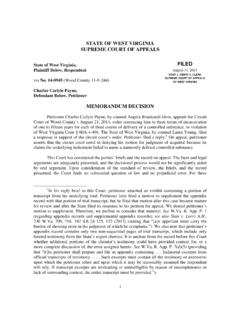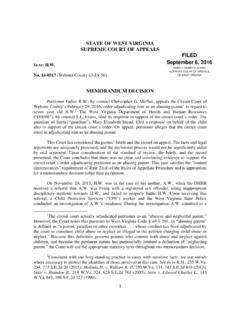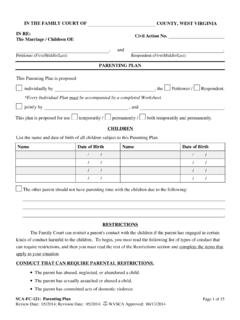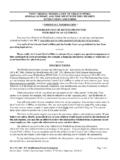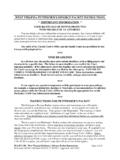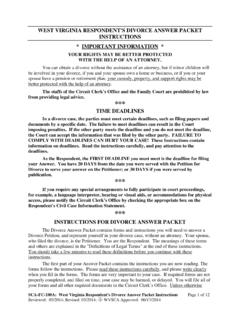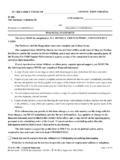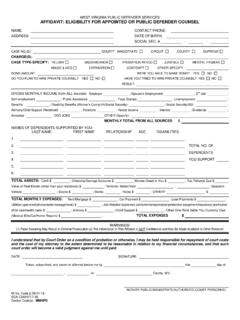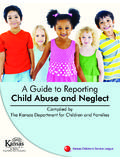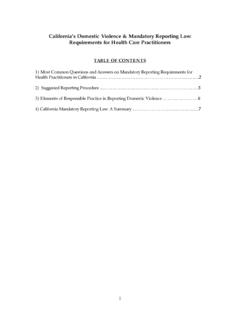Transcription of Dangerousness-Lethality Assessment Guide
1 Draft Do not Copy or Distribute Dangerousness-Lethality Assessment Guide A research-based Guide for systems interacting with families experiencing domestic violence. 1 2 3 4 The escalation of domestic violence to a highly dangerous/potentially lethal level follows a pattern with identifiable indicators1. If it is identifiable, it is predictable. This Guide will help professionals move through the following four steps in assessing domestic violence perpetrators for highly dangerous/potentially lethal behaviors and provide an effective response that heightens both safety measures for victims and accountability for highly dangerous/potentially lethal perpetrators: 1 These indicators are validated by a number of studies. See Campbell, Jacquelyn, et at, Intimate Partner Violence Risk Assessment Validations Study: The RAVE Study Practitioner Summary and Recommendations: Validation of Tools for Assessing Risk form Violence Intimate partners , National Institute of Justice (December, 2005); Heck-ert and Gondolf, Battered Women s Perceptions of Risk Versus Risk Factors and Instruments in Predicting Re-peat Reassault , Journal of Interpersonal Violence Vol 19, No 7 (July 2004).
2 Understand the nature and extent of the domestic violence. Prior training on the recognizing the differing contexts of domestic violence is critical in assessing the impact on families. Differentiating context of domestic violence involves asking who is doing what to whom and with what impact: Coercive controlling violence Resistive violence produced and shaped by coercive control Non-coercive controlling violence Identify highly dangerous/potentially lethal behaviors. This Guide will assist you in how to gather specific information and ask specific questions to determine if there are indicators for highly dangerous/potentially lethal behaviors. The best predictions of risk are a combination of victim s prediction of risk and a risk evaluation instrument (Gondolf and Heckert, 2004). Provide a heightened response when indicators are present.
3 Provide immediate safety planning and/or referrals for victim(s). Increase measures to contain highly dangerous/potentially lethal behaviors of perpetrator. Coordinate responses across systems. Coordinating assessments and responses is best practice for achieving victim safety and containing perpetrator behaviors. Remember confidentiality procedures/limitations applicable to your discipline when sharing information. Confidentiality is connected to victim safety. Draft Do not Copy or Distribute Dangerousness-Lethality Assessment Guide Why should we assess for indicators of highly dangerous/potentially lethal indicators in domestic violence cases? A consistent, research based process will: Provide a more accurate basis for effective safety planning with victims and accountability for perpetrators; Alleviate potentially inaccurate assumptions about dangerousness and lethality ; Provide a process for communicating potentially dangerous indicators across systems; Help professionals gather critical information and put individual incidents of violence into context to make decisions about how to respond; and Can SAVE LIVES.
4 Before assessing for indicators, it is important to understand the nature and extent of the domestic violence. While the legal definition of domestic violence meets a standard defined in WV statutes, families may experience behaviors that is contextually different and broader than the legal definition. Researchers have found that behaviors typically classified as domestic violence can look like: Coercive controlling violence include patterned behaviors such as physical, sexual, psychological/emotional and financial abuse, intimidation, threats, isolation, using children, using privilege, and minimization. The person using this type of violence has power over others in the family and operates from a belief that they are entitled to use such tactics of control. Resistive violence is produced and shaped by coercive controlling violence.
5 Victims of coercive controlling violence resist or fight back in self defense and/or use passive violence or retaliatory violence. Non-coercive controlling violence is violence between intimate partners or family members that does not include a pattern of behaviors where one person controls or has power over other members of the family. In the (intimate partner) femicide study, the majority of victims or perpetrators (up to 83%) or both had contact with criminal justice, victim assistance and/or health care agencies in the year prior to the homicide. (Campbell, J., PhD, , , Johns Hopkins University, Intimate Partner Homicide: Review and Implications of Research and Policy) Considerations When Assessing Indicators: Lack of indicators does not guarantee a victim is safe. Expert judgment should Guide intervention when danger is perceived.
6 Indicators should never be used to limit services. Understanding indicators is an ongoing process not a one time Assessment . Consider victim protective strategies as well as danger indicators. Draft Do not Copy or Distribute Law Enforcement Dangerousness-Lethality Assessment Guide Once the scene is secure, determine the nature and extent of the domestic violence. Gather information on indicators for highly dangerous/potentially lethal behaviors of perpetrator. Gather information from victim, offender, records, prior complaints, criminal history, dispatch, and Domestic Violence Registry. In addition to information gathered above, assess for indicators in victim interview (see Dangerous/ lethality Information Form for Law Enforcement Officers) Has he/she ever used a weapon against you? Has he/s ever threatened you with a weapon?
7 Does he/she have a gun or can he/she get one easily? Has he/she threatened to kill you or your children? Do you think that he/she might try to kill you? Has he/she ever tried to kill himself? Has he/she ever tried to choke you? Does he/she follow or spy on you or leave threatening messages? Is he/she violently or constantly jealous or does he/she control most of your daily activities? Has he or she forced you to have sex when you did not wish to do so? Have you left him/her or separated after living together or being married? Is he/she unemployed? Do you have a child that he/she know is not his/hers? Have your concerns of his/her behavior increased in the past few months? Are you concerned about his/her history with drugs or alcohol? Possession/use of weapons Direct threats to kill Victim perceived that offender might kill him/her Strangulation/choking Stalking Intrusive coercive control Forced sex Victim has left/attempting to leave the relationship Victim has child not the offender s biological child Offender is unemployed Violence is escalating Substance abuse may exacerbate danger If indicators of highly dangerous/potentially lethal behaviors are present,: Attach the dangerousness / lethality Information Sheet to the report.
8 Summarize highly dangerous/potentially lethal indicators on the complaint. Provide a heightened response (next page). 1 2 Questions for Victim Interview Indicators Is there anything else that worries you about your safety? Draft Do not Copy or Distribute Law Enforcement Dangerousness-Lethality Assessment Guide If there are any past or present indicators for highly dangerous, potentially lethal behaviors, consider the following heightened responses to: Increase Safety for Victim Reduce dangerousness of Offender Discuss the highly dangerous, potentially lethal indicators and express heightened concern for victim and child(ren) safety. Discuss heightened safety options with victim: Immediate referral to a domestic violence advocate if phone is available, and victim agrees, make contact with advocate on scene. Immediate transportation to a shelter (utilizing shelter intake protocol) or other safe place Immediate referral for domestic violence protection order Conduct follow up investigation ( ) Indicators for adult victims are also indicators for substantial risk of harm to children.
9 Follow model protocol for responding to risk of harm to children. Know that to stay safe, some victims will use the Address Confidentiality Program out of the WV Secretary of State s Office (Legislative Rule 153 CSR37) Immediate arrest with follow-up investigation increase the depth of the investigation Consider supplemental or other appropriate charges for the crime when they apply (following 149-3-7): malicious or unlawful wounding if strangulation present, Attempted murder, wonton endangerment if using a loaded firearm, sexual assault/abuse if forced sex, stalking, child abuse Child endangerment Non-DV specific charges Arrest for violation of bond conditions ( 62-1C-17c(d) -Affidavit Alleging Violation of Bond Condition) Discuss with the perpetrator the impact and dangerousness of behaviors on adult victim and children when appropriate.
10 Make CPS or APS referral System Collaboration Summarize highly dangerous/potentially lethal behaviors on complaint to communicate probable cause and potential risk to magistrate. Verify bond conditions with clerk of court or on-duty magistrate Appear at pre-trial hearing. Report substantial risk of harm to CPS/APS identify indicators on referral form/verbal report. Ensure prosecutor s office is aware of behaviors. Refer to and follow up with community and system based advocates. 3 4 Draft Do not Copy or Distribute Advocate Dangerousness-Lethality Assessment Guide When talking with potential victims of domestic violence, determine the nature and extent of the domestic violence. Gather information on indicators for highly dangerous/potentially lethal behaviors of perpetrators. Information can be gathered from victim, and other records if available ( law enforcement report, arrest records, DVPO s, criminal backgrounds, etc.)
